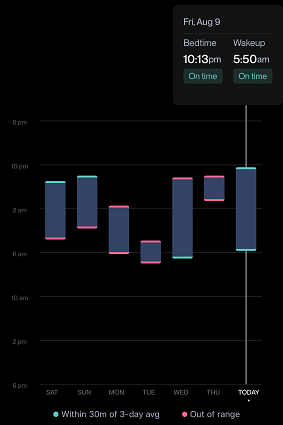
Eight Sleep says the Pod 4 can lower the temperature of the bed to 13 degrees, and raise it to 43 degrees. Smartly though, the app doesn’t use temperature figures by default (I would have had no idea what to set it to). Instead, it uses zero to denote a neutral temperature (which is about 27 degrees), and then lets you set it between minus 10 and plus 10. Obviously, cooling is going to be more difficult than warming for a compact unit like this, and Eight Sleep says it can generally manage to make the bed about 10 degrees cooler than the room.
The most impressive part is that the bed has two separate addressable zones, so partners can set their temperatures individually. I started at zero because I don’t mind the bed being cool when I get in, whereas my wife immediately set it to plus four (which is 34 degrees) and later upped it to plus six (which is 38 degrees). The cover starts warming an hour before our self-designated bedtimes, but you can start it manually if you want to get in earlier. In practice, our sides of the bed really do stay entirely different temperatures.
Loading
When I got in on the first night everything felt fine, but after half an hour or so I started feeling cold. I’m guessing this is because I’m used to the bed warming up gradually thanks to my body heat, whereas the Pod keeps temperature steady. I got used to it after a few nights, but you can always use the app to change temperatures separately for bedtime, early sleep and late sleep. Or, for a one-off solution in the middle of the night, you can change it immediately. There’s a dial in the app, and a pressure-sensitive panel on the side of each mattress you can whack to adjust (whack twice to cool, three times to heat). It works quickly, and despite my expectations, there are no watery sounds or sensations.
Finally, there’s a little vibration motor around shoulder height on the edge of each side. This buzzes to confirm when you’ve changed the temperature, but you can also set it to go off as an alarm, and it’s much more annoying than music. You can also have a spike of heat or cold to encourage you out of bed if you like, but that’s a step too far for me.
Obviously, there’s an AI element
But warming and cooling on demand is only part of the package. The rest is a machine-learning platform that claims to use proven research and heaps of tiny medical-grade sensors to document and improve your sleep. It monitors your movement, heart rate and breathing rate to map your sleep stages, documents snoring, and tracks factors that contribute to good sleep hygiene including consistency and duration. It also intervenes by autonomously adjusting temperature (and elevation, if you have the expensive model) and monitoring your response, building a personalised sleep profile over time.

Last week’s consistency stats makes it clear when it was my turn to settle a grumpy kid.Credit: Tim Biggs
The company calls this platform Autopilot, and says it’s clinically validated to give you more and better rest, aiming to match your body’s natural rhythm and temperature needs for deep and REM sleep. You need to buy a 12-month subscription when you buy the Pod, at a cost of $300. The subscriber can send an invitation to their partner for free, so a single sub tracks both people separately. If you decide to stop paying after a year, the Pod should still work, but it won’t track you, and you’ll need to change temperatures manually.
I’ve found the tracking very interesting, and it beats wearing a watch to bed. The focus on consistency threw me off at first (I set my bedtime for 10pm, so I expected it to be happy I went to bed right on time, but instead it said I was early because my three-day average was midnight) but overall, it’s easy to glance at daily and see what you’re doing right and what may be contributing to that morning listlessness. I was a little annoyed when I set my “early” temperature a bit warmer and Autopilot reversed the change a few days later, but I’ve been sleeping well so I guess it knows what it’s doing.
I’ve been using it for less than a month so I think it’s too early to say whether I’ve seen a meaningful increase in REM or deep sleep, but Autopilot definitely thinks it’s doing a good job. Among the stats and insights it serves up every day, it’s always keen to show how it made a change that increased REM by 8 per cent versus the average, though it never says exactly what it did. I was particularly sceptical of its claim that a 69 per cent reduction in snoring one night was due to its interventions. But the data does seem to ring true, even if the explanations for it could potentially be spurious.
One extra wrinkle is that I’m not sure the system was designed with people who are frequently woken up by nearby children in mind. Our four-year-old wakes in the middle of the night practically every night, and we take turns calming him, which often leads to just sleeping in his bed. This has made the consistency of my stats pretty ragged, and I have to assume it’s led the AI to conclusions that aren’t necessarily helpful.
Loading
But to its credit, the nights that I’ve spent entirely in my ownbed have been generally increasing in “quality” over the time I’ve had the Pod, with quality defined as more time in deep and REM sleep and strong heart rate variability.
Get news and reviews on technology, gadgets and gaming in our Technology newsletter every Friday. Sign up here.



























